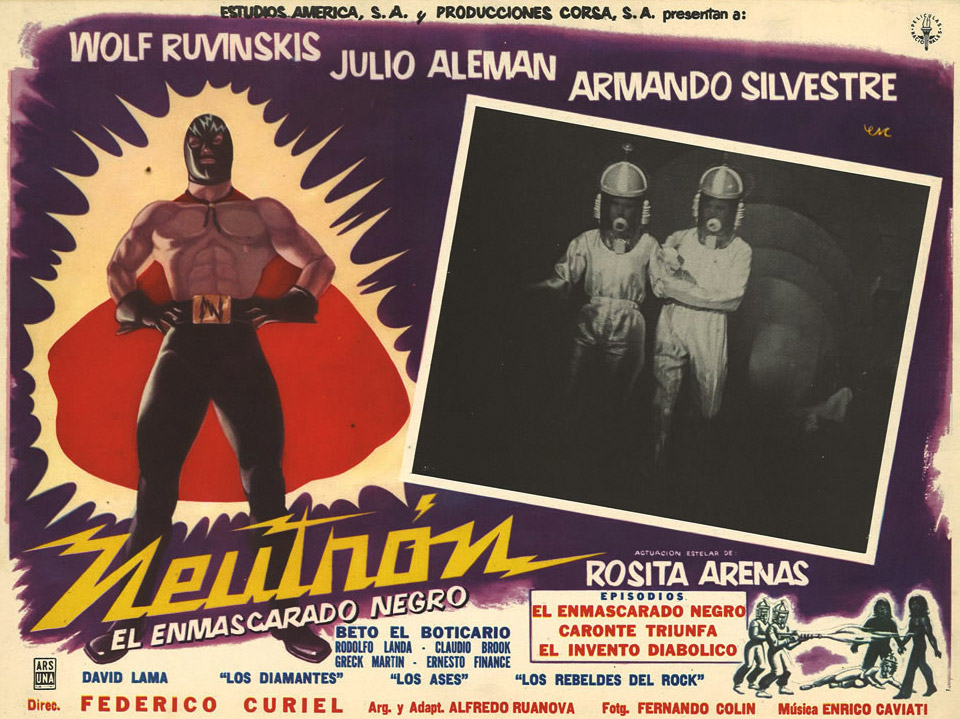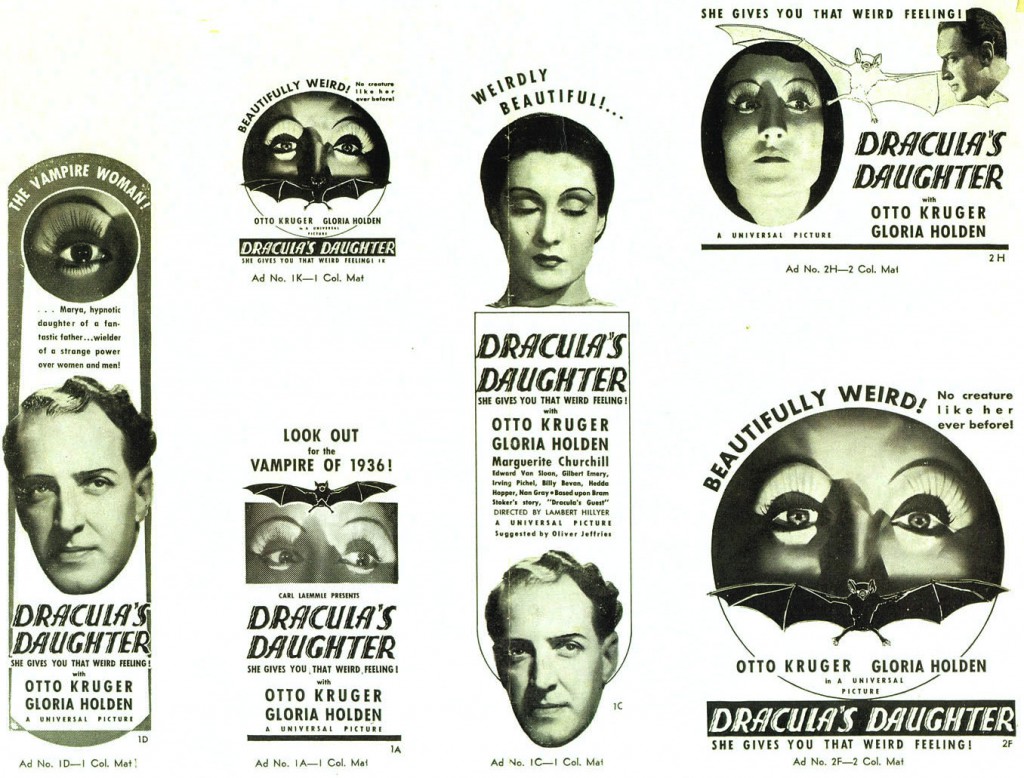Collectors and their obsessions are as varietal as the flora and fauna of a jungle. Under deep canopies of ephemera and artifacts, an archivist can still find more elements that are just waiting to be discovered. It might be movie posters in this case, or it could be vintage parts or even sports cards, but folks who have an affinity for the rounding up of rare items tend to see the world in a much different light. History is never lost on them and preservation is of the utmost importance.
The article below is from Collectors Weekly and goes into depth about Mexican film poster ads. If you find these interesting, also dive into one of our personal favorite archives, that of Russian Constructivist Posters and the famous Stenberg Brothers.
Link to article on Collector's Weekly
Primarily devoted to Mexican lobby cards, or small placards displayed in theater entrances to advertise upcoming films, and American pressbooks, which provided promotional guides for theater owners, Cozzoli has curated an extensive array of cult classics on his blog, Zombos’ Closet. Spanish-language lobby cards specifically piqued his interest because of their exaggerated details and wild graphics, unrestricted by more prudish American guidelines.
Cozzoli’s dream is to preserve these campy bits of horror film history, particularly items made during the golden era, which lasted from the 1940s through the ’60s. In the process, he’s created a virtual haunted house of zany, lurid, and sometimes downright disgusting marketing materials. Recently, we spoke to Cozzoli, who explained his passion for the weird world of horror-film memorabilia.
Add on the Shock! movies showing on local television, which were usually hosted by some wacky and creepy horror host, like Zacherley in New York, and I had a good upbringing on classic, and not-so-classic, cinematic horror every week.The article below is from Collectors Weekly and goes into depth about Mexican film poster ads. If you find these interesting, also dive into one of our personal favorite archives, that of Russian Constructivist Posters and the famous Stenberg Brothers.
Link to article on Collector's Weekly
 |
| A 1958 Mexican lobby card for “La Calavera Chillona,” or “The Screaming Skull.” |
John Cozzoli’s collection is frightening. Not because of its sheer size (though he does have over 500 film artifacts), but because Cozzoli’s ephemera all relates to lesser-known horror movies of the 20th century.
“Lon Chaney, Boris Karloff, and Bela Lugosi made it cool to be scared.”
Collectors Weekly: How did you first get into horror films?
John M. Cozzoli: Growing up in Brooklyn I was blessed with two movie theaters within walking distance: the Loews Oriental and the Benson, both on 86th Street. They played a lot of horror movies, and I have fond and frightening memories of the movies my mom took me to. She was a big horror fan, and I suppose that rubbed off on me, but I think deep down I was born a horror fan.The ephemera side must have come from my love of Famous Monsters of Filmland magazine and all the wonderful merchandise sold through Captain Company’s mail order catalog. Two blocks from my house was Joe’s Luncheonette, whose magazine rack was always full of comics and magazines distributed by Warren Publishing, like After Hours, Creepy, or Famous Monsters of Filmland, so I began collecting them. Unfortunately, I sold off my extensive collection just as the “investment” people (the ones dressed in suits) started showing up at Phil Seuling’s New York Comic Cons. But that’s another story. With the influences of the classic Universal monsters, Joe’s magazine rack, and my weekly allowance, it was a pretty sure bet I’d be a collector sooner than later.
 |
| Despite its alluring graphics, Cozzoli couldn’t find any records for the film “El Ataque de los Sombies.” |
Collectors Weekly: Do you consider yourself a B-movie expert?
Cozzoli: No, I’m just another fan with an opinion, only I try to back it up with experience and knowledge. When I tried to actually discuss movies with other fans on certain forum boards, I quickly realized there were many “experts” who had no sense of cinema history or composition, who were praising or cursing movies without being able to express why, using flaming to drown out anyone’s opinion that differed with theirs. Older “experts” knew nothing about modern horror cinema yet decried it as they cherished their decade or two’s worth of movie memories.“The more fears, the better the box-office receipts.”
 |
| “La Momia Azteca Contra El Robot Humano,” or “The Aztec Mummy Against the Humanoid Robot,” from 1958 featured a highly plausible battle scenario. |
I tend to be classic-centric, but I also love, and hate, modern horror movies. These days, the horror sub-genres are all over the place, so it’s hard to be an expert in everything. For me, the art of horror cinema officially starts with Universal’s “Dracula” and “Frankenstein,” and begins its descent to solid B, but still classy, movies in the 1940s with films like “Son of Frankenstein,” “The Wolf Man,” and “Creature from the Black Lagoon,” eventually hitting close to rock bottom with C- or D-grade fare from the 1950s drive-in circuit. Which is still fun to watch, by the way, especially with a rum and Coke.
Collectors Weekly: Where did the name “Zombos’ Closet” come from?
Cozzoli: I’m a big fan of “The Munsters” television show, and I kept all my comics, magazines, and collectibles in my bedroom closet as a kid. It was also the place I could run to, for personal reasons, where I could be alone and felt safe. I’d often pull out the Famous Monsters magazines and a flashlight while sealed up in my closet.There’s a great “Munsters” episode where little Eddy discovers his favorite TV horror host, Zombo, is not really very horrible. I felt bad ripping off the name as is, so I added an ‘s’ to the end of Zombo to create “Zombos.” I try not to say Zombos’s Closet because it sounds terrible—rhymes with thrombosis!—but maybe I should.
 |
| 1955′s “El Monstruo Del Millon De Ojos,” also known as “The Monster with a Million Eyes,” uses illustrated graphics to improve on special effects available at the time. |
Collectors Weekly: How do you select films to review?
I find out about movies by reading reviews, reading books about movies, reading other blogs—especially those from members of The League of Tana Tea Drinkers—and seeing trailers while I’m at the theater. Many times I’ll watch a movie, like “Frankenstein’s Castle of Freaks,” because, although I know I’ll hate it, I also know I’ll have a bang-up time writing the review. There are times I like to do a story framework around the review, using my characters that live in Zombos’ mansion [Cozzoli's blog features a cast of fictional characters based on horror film archetypes]. “Tokyo Gore Police“ is a perfect example: Insane movie equals wild fun to review. So if I feel I can have some gonzo fun while reviewing a movie, that’s a perk for me.Collectors Weekly: Is your collection limited to a specific era?
Cozzoli: Horror and exploitation themes have always been money-makers, no matter which era we’re talking about. Their cinema is malleable—its subgenres, themes, moods, and political or social insinuations, like any timeless drama, fit the period the movie is situated in. Most of the time. Then, of course, you have your schlock productions, which are always cheeky fun and surprisingly buoyant in the marketplace.The field of horror has long recognized the one truth of commercial and artistic cinema: There’s an audience out there for everything and anything, you just need to reach them. Now, of course, with YouTube, Facebook, etc., it’s a lot easier to reach that audience. Back then, you needed pressbooks and lobby cards to sell the merits of the movie.
You could successfully argue that Universal’s brand of horror provided the golden ticket to what followed, and Lon Chaney provided the template for horror actors to come. While you can’t dismiss or neglect the foreign horror silents and talkies, I’d put the mainstreaming of horror cinema squarely on the shoulders of Lon Chaney, Boris Karloff, and Bela Lugosi. They made horror accessible and approachable; they made it thrilling and cool to be scared.
Once the studios discovered that production runs could be trimmed, they budgeted more films. Eventually, formulaic movies took over, and by the 1950s, the youth audience became a viable target for generating revenue. More teenagers were going to the movies, a fact not lost on producers like Roger Corman. Drive-in theaters created a new milieu for horror films, and producers like William Castle noticed that younger kids were perfect audiences for “horror-light” movies like “House on Haunted Hill.”
 |
| This 1962 ad for “La Mano Del Diablo,” or “The Devil’s Hand,” uses a spiderweb to create a dynamic layout. |
All of this fed easily into the subject matter for horror: Our fears were shown to us. And the more fears, the better the box-office receipts.
 |
| 1968′s “El Doctor Loco De La Isla Sangrienta,” also known as “The Mad Doctor of Blood Island,” shows a particularly disturbing juxtaposition of graphic violence and sexuality. |
Collectors Weekly: What do you love about these low-budget films?
Cozzoli: There’s a mistaken belief that having a big budget guarantees a good movie: It doesn’t. Many movies with modest budgets have outdone movies with bigger pockets to draw from. I love seeing how creative a director and set designer can be when faced with limited resources to work from. Horror movies were originally A-listers, drawing notable actors and production teams. Over time they switched to B and C status as the studios realized they could still make a profit on a cheap movie. Even the bad movies sometimes show a sparkle of wit or style or dramatic directness that makes them enjoyable to watch.Now the really, really, really bad movies that look cheap and play cheap can also be fun because they don’t pretend to be anything but what they are. Look at how much zany and awkward cinema Ed Wood foisted on us, and how well regarded he is today by genre fans. “Plan 9 From Outer Space” is so inane and intentionally clumsy it’s sublime.
 |
| Cozzoli finds the homely Venusian from 1956′s “It Conquered the World” to be one of the least frightening B-movie monsters. |
Collectors Weekly: What are some of the lamest monsters you’ve come across in vintage horror films?
 |
| Other silly monsters in Cozzoli’s collection include the huge, one-eyed leeches from 1959′s “Attack of the Giant Leeches,” or “El Pantano Diabolico.” |
Collectors Weekly: Were these Mexican lobby cards made to advertise films from other countries?
Monster kid and movie historian Professor Kinema (Jim Knusch) was the person who turned me on to these wonderful examples of movie promotion for theaters. It was while perusing his collection of lobby cards and pressbooks that I fell in love with both. One reason I focus on Mexican lobby cards is because at $5 to $10 a pop, they’re a lot cheaper than American cards, making them easier to collect. Additionally, Mexican cards for native Spanish movies are usually more colorful and dynamic, and the Mexican cards come in larger sizes, which make them more interesting and displayable.
 |
| Cozzoli appreciates the complexity of lobby cards like 1979′s “Las Momias Asesinas,” or “The Mummy’s Killer,” which featured a recurring character called “El Latigo,” or “The Whip.” |
Moving from sophisticated to blatant exploitation, “La Bestia de La Noche Amarilla” is a great example of how bold a Mexican lobby card can be. The common element here, of domination over a scantily dressed female victim, is highlighted by each illustration: the monster’s blood-dripping, bone-chewing mouth looming over her; the monster’s beastly hand reaching for yet another screaming female victim; the monster standing over a victim. The illustrations don’t connect visually except for that theme.
 |
| 1971′s “La Bestia de la Noche Amarilla,” or “The Beast of the Yellow Night,” presents the more sensational side of Mexican lobby cards. |
Collectors Weekly: Why did they usually feature scantily clad females?
Sex sells whatever product you hawk with it—just look at all those Chippendale Calendars, or next time you’re in an auto shop, see who’s holding that oil can on a poster or dressed in a bikini and smiling by an engine on a calendar. But darker insinuations can also be found in the cards: Female victims are repeatedly stalked or tortured by these male monsters, and all done with their clothes in tatters, or dressed in some flimsy nightgown.
 |
| Sexy witches abound in this ad for 1969′s “Las Brujas Del Infierno,” or “The Witches from Hell,” a tactic that helped fill theater seats. |
Collectors Weekly: Do you have a favorite lobby card?
 |
Cozzoli’s
current favorite is a lobby card for “El Charro de las Calaveras,”
translated as “The Cowboy of the Skulls,” a Western-horror flick from
1965.
|
Collectors Weekly: What’s the deal with the masked wrestler lobby cards?
It’s a natural to have the luchadores come up against monsters like mummies, vampires, and zombies. Why not? The luchador is the Spanish version of our superhero. If you can accept guys flying around in capes and wearing masks, well, it’s the same thing. Just look at “Neutron: El Enmascarado Negro.” The Italian equivalent would be peplum movies.
 |
| The luchador or masked wrestler is Mexico’s version of the American superhero. |
Collectors Weekly: What sorts of other common themes do these lobby cards use?
The main themes are violence, sexuality, and deprivation (of liberty, life, sanity, humanity, etc.), although it depends on the movie as to their intensity, or even if all three are used on one card. The Spanish-speaking movie lobbies lean toward exploiting these themes more often, so I’ll use them as examples.
“La Mente y el Crimen” is a good example of all three themes being present. We see what’s on the man’s mind, and it hints at sexuality and deviance, while violence and deprivation are shown through the hand wielding a bloody knife. In this particular case, the photo inset, of the voodoo doll with pins stuck into it, adds to the overall tone of the card. And note the doll is feminine.
 |
1964′s “La Mente y el Crimen,” or “The
Mind and the Crime,” features common lobby card imagery of violence,
sexuality, and deprivation.
|
Finally, look at “El Satanico.” The artwork may be primitive, but it screams at you to see this movie. The subtle cues are how the knife-wielding guy in the upper corner is staring down, over the cityscape, at the other guy holding a gun. The jagged white backdrop for the title font is very aggressive and counterpoints the tip of the knife while bringing attention to it. Assuming you can stop looking at the bikini-clad babe on the left, that is."


